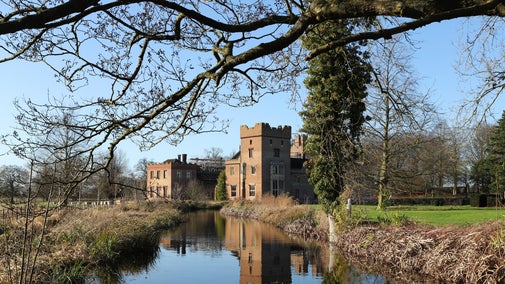
Donate
Everyone needs nature, now more than ever. Donate today and you could help people and nature to thrive at the places we care for.

Every five years we work with local contractors to protect the timbers and plaster of Lavenham Guildhall by applying several coats of limewash. Find out more about the process, why it’s so important for timber-framed buildings like the Guildhall and how we carry out the work.
East Anglia has a wealth of timber-framed buildings, many of which, like the Guildhall, were built with exuberant carvings to display the carpenter’s skills as well as the owner’s wealth. These carved timbers were intended to be seen and some were covered by a skin of lime render.
As part of our conservation of the Guildhall and to protect its intricate 16th-century carvings, every five years we coat the entire Guildhall building with several coats of limewash.
Limewashing is a traditional preservative. Exposed timber frames are painted with a ‘wash’ of lime that acts as a preservative against pollutants and other destructive elements in the atmosphere.
The lime becomes ingrained in the beams, preventing moisture from penetrating while allowing the wood to breathe. It also prevents bug infestations. Two or three coats are applied, after which any excess is brushed off.

The timbers of the Guildhall would have originally looked as they do today, with a limewash finish. It was only during Victorian times that it became more fashionable to use oil-based paints, or to darken the timbers with black emulsion.
Unfortunately, this can cause more harm to the timber frames as it seals in the moisture. This makes woodworm and death watch beetle infestations more likely to develop as the treatment isn't breathable.
In keeping with the Guildhall’s history, we take great care to preserve the building’s original nature by using authentic and original quality coatings and products – in this case, limewash. Over time the weather removes the lime, showing the weathered oak as a silver-grey colour.
A project on a grand scale like this takes a lot of planning and managing and, as it’s an exterior job, progress can be affected by the weather. We work with local producers and contractors for both the limewash itself and the application and execution of the project.
The work takes between eight and 10 weeks, and we usually apply three coats of the limewash. We don’t need to limewash both the plaster and the timbers every time; in 2012 we did both but in 2017 only the plaster required work.

Scaffolding is unsightly on a building such as the Guildhall, but it’s the safest and most efficient way to get up close to the surfaces for the initial inspection and to apply the limewash thoroughly.
You might imagine we spray the limewash onto the building but in fact it’s all done by hand. This is the only way can we ensure the limewash is thoroughly ingrained into the fabric of the building and therefore protected from the weather and pollutants for the next five years.
Limewash is a hazardous material which can cause irritation and damage to the eyes and skin, so we must be very careful when we are applying it. We protect nearby plants and wildlife, both on our site and on neighbouring properties.
With your ongoing support, we're able to continue our vital conservation work. Thank you for helping to protect these special places.

Everyone needs nature, now more than ever. Donate today and you could help people and nature to thrive at the places we care for.
Immerse yourself in 500 years of colourful history at Lavenham Guildhall. Discover the people that shaped the unique building and the nature of Lavenham itself.

Uncover the history of Lavenham village, once a thriving centre of the prosperous ‘blew’ cloth trade and home to the little-known author of a world-famous nursery rhyme.

Educational and fun, there's lots for every member of the family to enjoy on a day out at Lavenham Guildhall.

We believe that nature, beauty and history are for everyone. That’s why we’re supporting wildlife, protecting historic sites and more. Find out about our work.

Read about our strategy, which focuses on restoring nature, ending unequal access and inspiring more people.
